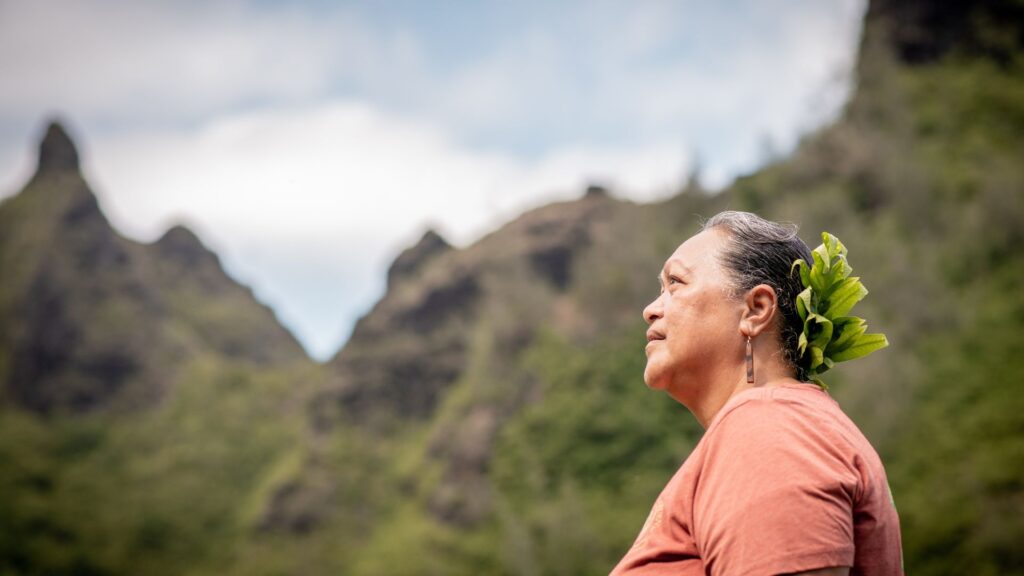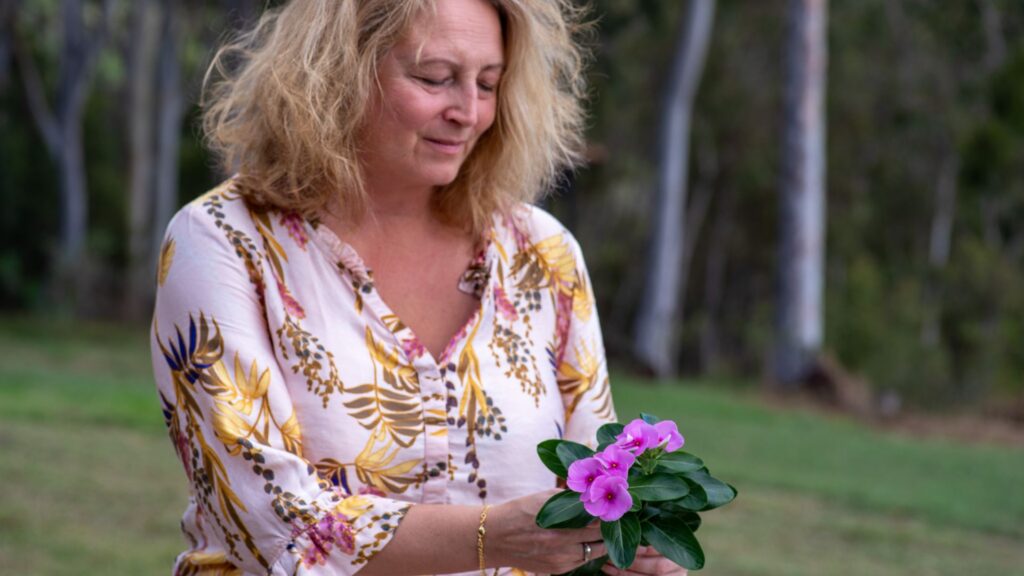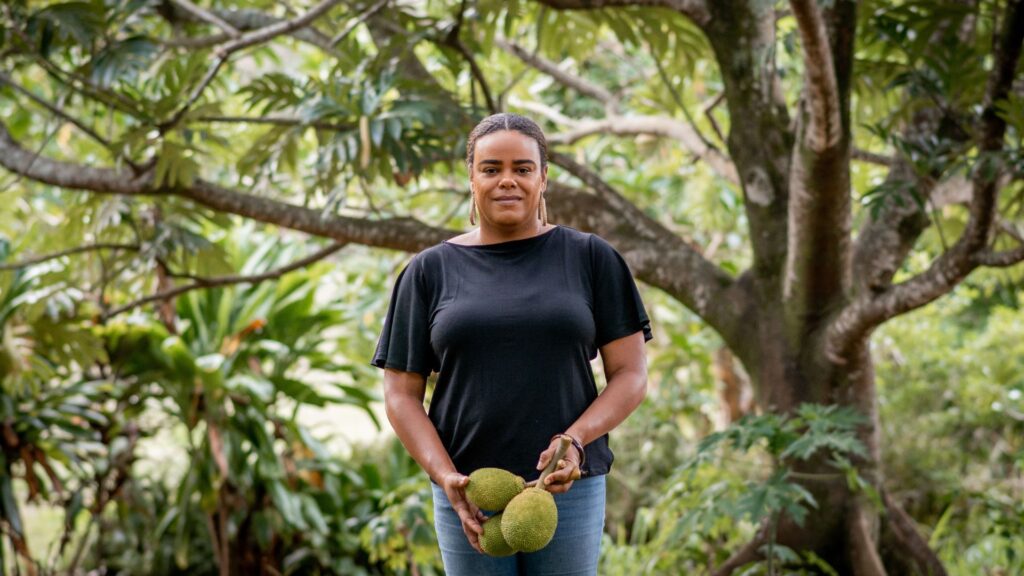People need plants. They are the root cause of our health, habitat, and happiness. More than ever, plants need you. Join us this fall as we explore how cultivating deeper connections with plants can grow a brighter tomorrow for our ecosystems and communities.
If you haven’t thought about plants today, you’re certainly not alone. Even though plants make our everyday possible, many of us seldom pause to appreciate just how important they are to our health and overall wellbeing. Plants and people go together. In the Hawaiian worldview, kalo (taro) is an older sibling who continues to feed and nourish communities across the islands. Ola ke kalo, ola ke kānaka; ola ke kānaka, ola ke kalo is a Hawaiian proverb that means if kalo lives, Hawaiians live; if Hawaiians live, kalo lives.
(L) Breadfruit being gathered at the Regenerative Organic Breadfruit Agroforest. (R) Noah Kaaumoana-Texeira gathering kalo (taro)
“In some Native languages, the term for plants translates to ‘those who take care of us,’” says Potawatomi botanist and Braiding Sweetgrass author, Robin Wall Kimmerer. From lowering stress and anxiety, to producing cancer-fighting compounds and healthy regenerative agriculture systems, plants are often our best teacher and most helpful remedy. Increasing our awareness and recognition of plants is the first step in protecting our precious biodiversity. Our future depends on it.

Lahela Chandler Correa, Visitor Program Manager at Limahuli Garden & Preserve
Plants feed, shelter, heal, and fuel us. They inspire art, help us express emotion, and guide many of our cultural and spiritual practices. Data also shows that spending time in nature improves our mental and physical health. So, why do we often overlook their importance to all life on Earth and limit our interest in plant conservation?
Researchers have noted a growing indifference to plants. There are many reasons for plant unawareness. In urban areas, many people lack equitable access to plants, parks, and natural spaces. Plants are underrepresented in education. From kindergarten to college, plant science is fading from curriculum and school programs. It also has to do with what’s inside our heads: since most plant life is similar in color, mostly stationary, and densely packed, our brains can be hardwired to lump them together instead of noting their differences. In other words, many of us tend to see the forest and not the trees. Importantly, awareness for plants differs across cultures. Most research on the topic has been done in Western societies, whereas Indigenous communities often have a deep and fundamental awareness of plants.
We must increase our awareness and empathy for the plant life surrounding and supporting us. In his 1968 speech to the International Union for Conservation of Nature, Senegalese conservationist Baba Dioum said, “In the end, we will conserve only what we love; we will love only what we understand and we will understand only what we are taught.” The more we engage with plants and experience their positive effects on our health and wellbeing, the more likely we are to protect them. It’s time to become plant passionate.
(L) Dr. Nina Ronsted examines an herbarium voucher of Madagascar periwinkle. (R) Close-up of Madagascar periwinkle
Plants have always healed us and today are found in a quarter of our medicines. Yet, most drug researchers focus on synthetically-derived medicines. Despite technological progress, the number of new drugs brought to the market is in decline. However, drug discovery from plants and other natural products continues to be highly productive and effective.
“Today, we are still challenged by a long list of unmet medical needs for safe and effective medicines,” said Nina Ronsted, NTBG’s Director of Science and Conservation. “One of the grand challenges for humankind remains the identification of new leads for pharmaceutical research,” she continued. The need for new leads is just one reason plant science and conservation are essential not only to the health of our planet but also to our people. “It is not easy to guess which plants might cure which diseases,” said Nina. “As extinction accelerates, we risk losing potential medicines even before they are discovered,” she concluded.

Director of Science and Conservation, Dr. Nina Ronsted, admires Madagascar periwinkle flowers
In recent history, compounds from the Madagascar periwinkle have increased the survival rate of childhood leukemia from 10% to 90%. In addition, a compound initially found in Pacific Yew trees (Taxus brevifolia), is the cancer-fighting component of Taxol. This drug inhibits the rapid multiplication of cancer cells. Today, Taxol is on the World Health Organization’s list of Essential Medicines and is one of the most effective drugs for treating multiple forms of cancer.
“The potentially useful compounds that plants have developed over time in response to herbivores overcoming their effects are increasingly complex and specialized,” noted Nina. “Many of these compounds may affect humans and become cures for diseases,” she finished.
With time, plant research and conservation will reveal more about the connection between plant compounds and human health. But what can we do today to strengthen our connection and improve our health right now? The answer is a walk in the park (or garden!).

Noel Dickinson, Breadfruit Institute Coordinator, holding breadfruit in the Regenerative Organic Breadfruit Agroforest (ROBA)
On any given weekday, you’ll find Noel Dickinson of NTBG’s Breadfruit Institute tending to the trees and edible understory plants in the Regenerative Organic Breadfruit Agroforestry (ROBA) demonstration in NTBG’s McBryde Garden. Breadfruit has long been an important staple crop and a primary component of traditional agroforestry systems in Oceania. In addition to providing food and goods, breadfruit agroforests offer broad ecosystem benefits such as soil and water conservation and biodiversity maintenance essential to long-term island habitation. ROBA is a two-acre display garden and model for implementing breadfruit agroforestry in tropical regions and areas of food scarcity worldwide.
For Noel, breadfruit agroforestry does more than produce nutritious food and regenerate land degraded by erosion, compaction, and loss of organic matter. It nurtures her, builds relationships, and provides an opportunity to learn and grow. “Plants are a huge part of my life, personally and professionally, and breadfruit has had a big impact on me,” said Noel. “Through my work with the Breadfruit Institute at NTBG, I have been able to learn new things as well as literally share the fruits of my labor with my community,” she effused. “I have also, at times, been given a platform to represent the gardens,” she said. “Being an ambassador for not only breadfruit but also NTBG is a great joy for me.”
Studies show it’s not just Noel benefitting from time spent with plants. Plants can generate happiness, reduce stress, and increase positive energy in the home. In addition, access to parks and outdoor spaces increases rates of physical activity and overall healthiness. Research also shows that people who spend more time around plants have better relationships with the people around them.
(L) A ripening breadfruit amongst colorful ti leaves in the Regenerative Organic Breadfruit Agroforest. (R) Noel Dickinson, Breadfruit Institute Coordinator, gathering breadfruit in ROBA
Plants and people are inextricably linked. From everyday wellbeing to the next medical breakthrough, we need plants to maintain our health and the health of our planet today. As we navigate and study the effects of climate change, our future also depends on our ability to recognize the plant life surrounding us, learn from it and investigate solutions for what lies ahead.
Plants nourish our ecosystems and communities in countless ways. When we care for plants, they continue caring for us. Help us grow a brighter tomorrow for tropical plants.